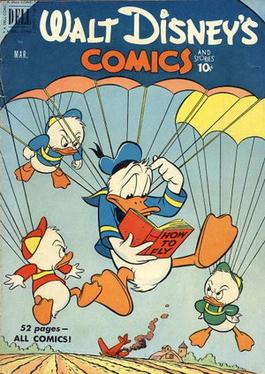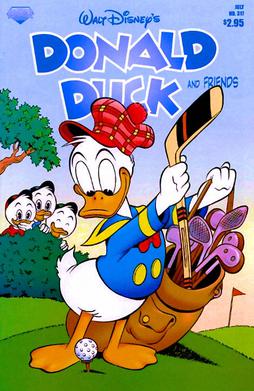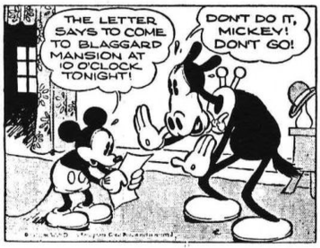Related Research Articles

Song of the South is a 1946 American live-action/animated musical comedy-drama film directed by Harve Foster and Wilfred Jackson, produced by Walt Disney, and released by RKO Radio Pictures. It is based on the Uncle Remus stories as adapted by Joel Chandler Harris, stars James Baskett in his final film role, and features the voices of Johnny Lee, Baskett, and Nick Stewart. The film takes place in the U.S. state of Georgia during the Reconstruction era, a period of American history after the end of the American Civil War and the abolition of slavery. The story follows seven-year-old Johnny who is visiting his grandmother's plantation for an extended stay. Johnny befriends Uncle Remus (Baskett), an elderly worker on the plantation, and takes joy in hearing his tales about the adventures of Br'er Rabbit (Lee), Br'er Fox, and Br'er Bear. Johnny learns from the stories how to cope with the challenges he is experiencing while living on the plantation.
Disney comics are comic books and comic strips featuring characters created by the Walt Disney Company, including Mickey Mouse, Donald Duck and Scrooge McDuck.

Walt Disney's Comics and Stories, sometimes abbreviated WDC&S, is an American anthology comic book series featuring characters from The Walt Disney Company's films and shorts, including Donald Duck, Scrooge McDuck, Mickey Mouse, Chip 'n Dale, Li'l Bad Wolf, Scamp, Bucky Bug, Grandma Duck, Brer Rabbit, Winnie the Pooh, and others. With more than 700 issues, Walt Disney's Comics & Stories is the longest-running Disney comic book in the United States, making it the flagship title, and is one of the best-selling comic books of all time.

Donald Duck, also known as Donald Duck and Friends, is an American Disney comic book series starring the character Donald Duck and published by various publishers from October 1942 to June 2017. As with many early Disney comics titles, Donald Duck began as individual issues of Dell Comics' Four Color one-shots series. It was published as its own regular series in November 1952, starting with issue #26.

Uncle Remus is the fictional title character and narrator of a collection of African American folktales compiled and adapted by Joel Chandler Harris and published in book form in 1881. Harris was a journalist in post–Reconstruction era Atlanta, and he produced seven Uncle Remus books. He did so by introducing tales that he had heard and framing them in the plantation context. He wrote his stories in a dialect which was his interpretation of the Deep South African-American language of the time. For these framing and stylistic choices, Harris's collection has garnered controversy since its publication.
Paul Murry was an American cartoonist and comics artist. He is best known for his Disney comics, which appeared in Dell Comics and Gold Key Comics from 1946 to 1984, particularly the Mickey Mouse and Goofy three-part adventure stories in Walt Disney's Comics and Stories.
William Crozier Walsh was a film producer, screenwriter and comics writer who primarily worked on live-action films for Walt Disney Productions. He was born in New York City. For his work on Mary Poppins, he shared Academy Award nominations for Best Picture with Walt Disney, and for Best Writing, Screenplay Based on Material from Another Medium with Don DaGradi. He also wrote the Mickey Mouse comic strip for more than two decades.
Manuel Gonzales was a Spanish-American Disney comics artist. He worked on the Mickey Mouse comic strip from 1940 to 1981.
Walt Disney's Treasury of Classic Tales is an American Disney comic strip, which ran on Sundays in newspapers from July 13, 1952, until February 15, 1987. It was distributed by King Features Syndicate. Each story adapted a different Disney film, such as Darby O'Gill and the Little People, Peter Pan, or Davy Crockett. It was run in relatively few papers, with 58 in 1957 and 55 in 1966, and was principally a vehicle for promoting new and re-released Disney films.
Walt Disney Comics Digest is one of three digest size comics published by Gold Key Comics in the early 1970s. The other two were Mystery Comics Digest and Golden Comics Digest. It was the first digest-sized regular Disney comic published in the US, and was very successful, offering relief from the company's slipping comic book sales.
Scamp is a canine Disney comics character, the son of Lady and Tramp, all of whom appear in the 1955 animated film Lady and the Tramp. Scamp is featured in comic strips and comic books of his own since the 1950s. In the final scene of the film, the dogs have a litter of puppies, including three girl pups who look like Lady, and a mischievous, restless boy pup who resembles Tramp. The puppies are unnamed in the film and only appear in one scene, but the little boy puppy made an impression, and King Features Syndicate launched a comic strip a few months after the film's release.

Kalle Anka & C:o is a Swedish weekly Disney comics magazine, published by Egmont. The 52-page comic, launched in September 1948, is the overall best-selling Swedish comic magazine. In the early years, the comic printed translated stories from the United States, including Walt Disney's Comics and Stories, Four Color and other Dell Comics Disney titles. As Disney comics production waned in the United States in the 1960s, Kalle Anka began printing more European-produced content, from Scandinavia and Italy. Now, Kalle Anka & C:o and its Scandinavian sister editions Anders And & Co. (Denmark) and Donald Duck & Co (Norway) are identical, apart from the language.

Br'er Rabbit is a central figure in an oral tradition passed down by African-Americans of the Southern United States and African descendants in the Caribbean, notably Afro-Bahamians and Turks and Caicos Islanders. He is a trickster who succeeds by his wits rather than by brawn, provoking authority figures and bending social mores as he sees fit. Popular adaptations of the character, originally recorded by Joel Chandler Harris in the 19th century, include Walt Disney Productions' Song of the South in 1946.

Mickey Mouse is a Disney comic book series that has a long-running history, first appearing in 1943 as part of the Four Color one-shot series. It received its own numbering system with issue #28, and after many iterations with various publishers, ended with #330 from IDW Publishing.

Br'er Fox and Br'er Bear are fictional characters from African-American oral traditions popular in the Southern United States. These characters have been recorded by many different folklorists, but are most well-known from the folktales adapted and compiled by Joel Chandler Harris, featuring his character Uncle Remus.
Riley A. Thomson Jr. was an American animator and comics artist who spent most of his career working with Walt Disney films and characters. He directed six Disney short films including The Nifty Nineties and Symphony Hour.
George Vernon Stallings was an American animation director and writer. He started working for Bray Productions in 1916 where he directed the Colonel Heeza Liar series of shorts, and the Krazy Kat shorts. He invented "the animation disk placed in the centre of the drawing board" in the 1920s. Its primary use by 1930 was as an aid in inking cels. He then worked for Van Beuren Studios from 1931 through 1934.
Donald Duck is an American comic strip by the Walt Disney Company starring Donald Duck, distributed by King Features Syndicate. The first daily Donald Duck strip debuted in American newspapers on February 7, 1938. On December 10, 1939, the strip expanded to a Sunday page as well. Writer Bob Karp and artist Al Taliaferro worked together on the strip for more than 30 years. The strip ended in May 1995.

Mickey Mouse is an American newspaper comic strip by the Walt Disney Company featuring Mickey Mouse and is the first published example of Disney comics. The strip debuted on January 13, 1930, and ran until July 29, 1995. It was syndicated by King Features Syndicate until 1990, when Disney switched to Creators Syndicate, which distributed the strip until 2014.
Silly Symphony is a weekly Disney comic strip that debuted on January 10, 1932, as a topper for the Mickey Mouse strip's Sunday page. The strip featured adaptations of Walt Disney's popular short film series, Silly Symphony, which released 75 cartoons from 1929 to 1939, as well as other cartoons and animated films. The comic strip outlived its parent series by six years, ending on October 7, 1945.
References
- 1 2 3 4 Holtz, Allan (2012). American Newspaper Comics: An Encyclopedic Reference Guide. Ann Arbor: The University of Michigan Press. p. 400. ISBN 9780472117567.
- ↑ Holtz, Allan (2012). American Newspaper Comics: An Encyclopedic Reference Guide. Ann Arbor: The University of Michigan Press. p. 351. ISBN 9780472117567.
- ↑ Becattini, Alberto (2016). Disney Comics: The Whole Story. Theme Park Press. p. 24. ISBN 978-1683900177.
- ↑ Markstein, Don. "Br'er Rabbit". Don Markstein's Toonopedia. Archived from the original on May 27, 2024. Retrieved January 18, 2007.
- 1 2 3 4 5 6 Becattini, Alberto (2019). "Genesis and Early Development". American Funny Animal Comics in the 20th Century: Volume One. Seattle, WA: Theme Park Press. ISBN 978-1683901860.
- ↑ Holtz, Allan (2012). American Newspaper Comics: An Encyclopedic Reference Guide. Ann Arbor: The University of Michigan Press. p. 83. ISBN 9780472117567.
- 1 2 3 Korkis, Jim (2012). Who's Afraid of the Song of the South? And Other Forbidden Disney Stories . Theme Park Press. ISBN 978-0984341559.
- 1 2 3 Horn, Maurice (1996). 100 Years of American Newspaper Comics: An Illustrated Encyclopedia. New York: Random House. p. 383. ISBN 0-517-12447-5.
- ↑ "Brer Rabbit, ZB 4501". Inducks . Retrieved 28 July 2019.
- ↑ "Brer Rabbit, ZB 4502". Inducks . Retrieved 28 July 2019.
- ↑ "Brer Rabbit, ZB 4503". Inducks . Retrieved 28 July 2019.